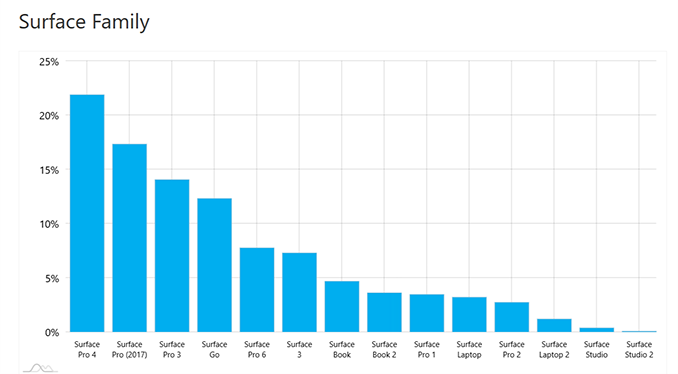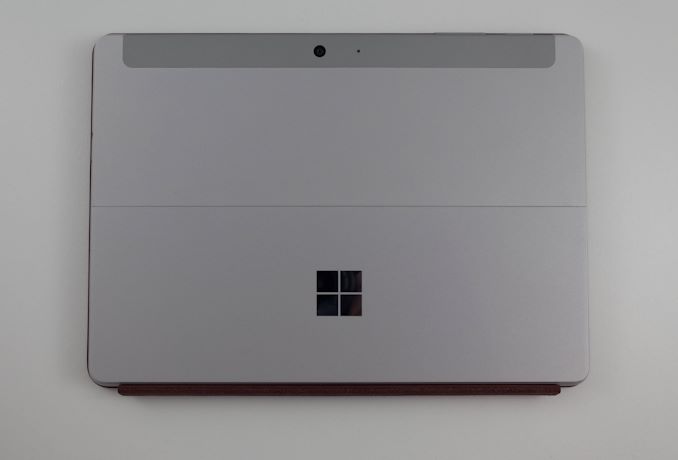The Microsoft Surface Go LTE Review: Unmatched Mobility
by Brett Howse on January 17, 2019 8:00 AM ESTFinal Words
The Surface Go sits in a somewhat interesting segment of the market. The base model has a price that’s low enough to be considered a value proposition, but like all value devices, there’s compromise to get there. The $399 starting price includes just 4 GB of RAM, and 64 GB of eMMC storage, which is outright the bare minimum that would even be usable with Windows 10. Microsoft now offers a 4 GB model with the 128 GB SSD for $499, which is already a price that’s creeping out of the value segment. 8 GB of RAM is $549, which is a lot for a low-end device. If you want to add LTE, the price starts at $679 with 8 GB of RAM and 128 GB of storage, and business customers will be able to purchase a 256 GB model as well. Then you must add in the price of the Type Cover, which starts at $99, and is realistically a required accessory.
A model with 8 GB of RAM and the Type Cover is therefore about $650, or a bit more if you choose a Signature Type Cover. That’s a lot more than the $399 get-you-in-the-door price, and really moves the Surface Go up a couple of rungs on the pricing ladder.
But the Surface Go does have some very good qualities going for it. The build quality is certainly a step above anything else in this price range on the PC side, with a fantastic magnesium body, a built-in kickstand which is every bit as good as the Surface Pro’s, and a very light weight. Even with the Type Cover attached, the device still only weighs 767 grams, or about 1.7 lbs, and coupled with the small size, makes the Surface Go extremely portable. Add in the fact that it works with the Surface Pen, and you can see an easy use case in a small, but expensive, note taking machine.
Microsoft also color calibrates all of its displays, and you would be hard pressed to find anything else in the PC space at this price range with as accurate of a display. The Go’s display isn’t the highest density one around, but at 216 pixels-per-inch, it still offers great clarity, and good contrast as well. Microsoft offers better displays on some of its other devices, but this is still a high quality display and very pleasing to use.
However, there’s some drawbacks as well. At the introductory price of $399, the underwhelming performance fits in with much of the competition, where Intel’s Atom is the name of the game. Despite Microsoft moving to a Core-based Pentium in the Surface Go, it’s disappointing to see where it stacks up: more or less even in terms of CPU performance with Intel’s latest Atom processor. At $399, that’s kind of expected, but since most people should buy the model with 8 GB of RAM, and a Type Cover, all of a sudden the Pentium Gold kind of looks out of place in a $650 PC. The performance is well above the previous non-Pro Surface 3 tablet, but the expectations have also progressed.
We’ve already touched on this, but this is a tough spot in the market for companies to try to launch quality devices for less money. Intel has a stranglehold on the market, and has taken the stance that Core branded products are sacred. Its margins must be protected. AMD doesn’t really offer anything that would compete in terms of power usage, and Qualcomm doesn’t offer anything in terms of performance. If Intel offered even a modest amount of Turbo on the Pentium Gold range, it would help tremendously, but they don’t. It’s an unfortunate spot to be in today.
The other real drawback is the battery life, which really comes down to battery capacity. At 27 Wh, there’s just no way the Surface Go can ever really be expected to provide a full day of work out of a single charge, and on a device this portable, that’s a drawback. This is why it is great to see USB-C on the Surface Go. Microsoft has never really supported this connector, but if there was a single device where it makes sense, it is this one. The Surface Connect charger is a convenient method of magnetically connecting a charger on your desk, but being able to charge off of a USB-C charger slightly mitigates the battery concerns, and would even allow a power back to be attached if necessary.
What was a great move though was coming out with this LTE model. Yes, you can always tether a laptop to a phone’s cellular connection over Wi-Fi, but for those that need something that’s always connected, that’s not the ideal solution. Having built-in LTE really expands the use cases for the Surface Go, especially in business. Having employees being able to be mobile, but still being able to manage their PCs, is an appealing draw. This is definitely not a feature everyone needs, and the $130 price increase, plus the monthly data fee, strikes that point home. But for those that need it, this is invaluable.

Source: AdDuplex.com
Despite the performance and battery life, Surface Go looks to be a bit of a hit, with a usage share already higher than many Surface devices that have been on the market longer. Clearly the small size and good build quality is something people are looking for. Adding LTE to that increases the mobility further, and although Microsoft likely won’t sell more LTE models than WI-FI, it definitely increases the potential market. And, despite the Surface Go being priced at a premium for a small form factor convertible tablet, it is still priced well under the entry level Surface Pro 6. The Pro 6 offers much higher performance, a bigger, nicer display, better battery life, and a keyboard that doesn’t feel cramped. But the Surface Go is smaller, lighter, and less expensive. With already 12% of the Surface usage share, that appears to be a winning formula.













79 Comments
View All Comments
cpkennit83 - Thursday, January 17, 2019 - link
a 3ghz a76 based qualcomm soc should murder than pentium in recompiled apps while being decent in legacy code. Cant arrive soon enoughtcpkennit83 - Thursday, January 17, 2019 - link
and at double battery life i should add. Plus it wouldnt require an additional modem chipprophet001 - Thursday, January 17, 2019 - link
at 6 watts?jordanclock - Thursday, January 17, 2019 - link
That's about a 50% bump in what the SD855 averages, according to Anandtech's quick review of the SD855 QRD. Roughly comparing the numbers, the SD855 isn't very far off in some of the raw numbers. But cpkennit83 is right that it will take apps being recompiled for arm64 to get real world numbers to match up.cpkennit83 - Thursday, January 17, 2019 - link
the 855 does 2w in specint and 2.5w in specfp, so it should have plenty headroom. a 3ghz version with 512kb L2 in all cores would still be comfortably under 5w. Only problem is software.Prestissimo - Saturday, January 19, 2019 - link
Reality of Windows on ARM is far from ideal. SD850 has shown to draw 8W on average on a 13.3" FHD IPS touchscreen, which is similar to 4.5W Core M (2C/4T) and only marginally more efficient than 15W Core U (4C/8T).Notebookcheck's numbers demonstrates Lenovo C630 (13" FHD, SD850, 60 Wh) measured 12 hours on a 60 Wh battery, while Dell XPS 13 9370 (13" FHD, i5-8250U, 52 Wh) with an even smaller battery recorded almost 11 hours with markedly better power consumption. Not counting factors like the fact that XPS has a far better screen, faster memory and storage all pointing to higher overall power consumption.
https://www.notebookcheck.net/Lenovo-Yoga-C630-WOS...
https://www.notebookcheck.net/Dell-XPS-13-9370-Cor...
HStewart - Saturday, January 19, 2019 - link
Yes - with latest 8th gen notebooks, it is even better now - but wait to Sunny Cove. But keep in mind Windows for ARM with real application (not apps) has far less performance.MrSpadge - Thursday, January 17, 2019 - link
I wish it had a fully featured Kaby Lake-Y with turbo. That may be worth 100$ more for many, yet cost the same to produce.Prestissimo - Saturday, January 19, 2019 - link
I think Intel Core i3 U would make a much better selection, Whiskey Lake i3-8145U for instance.Prestissimo - Saturday, January 19, 2019 - link
Or Microsoft could team up with Apple and make a mid-range Surface with a 7nm SoC like the A12X Bionic, finally delivering great performance AND battery life on a tablet PC. Wouldn't that be something.